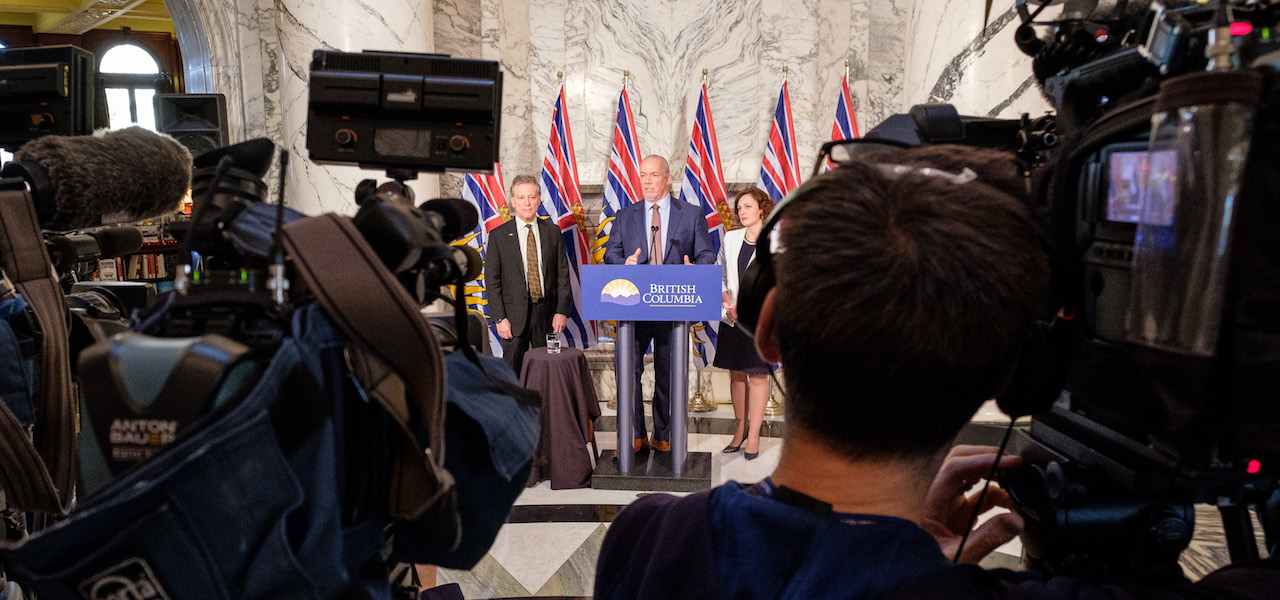Site C’s economic justifications unconvincing: It’s time we made decisions differently
There is no question that the new BC government’s decision to proceed with the Site C dam was a very difficult one. The previous government left them with a poison pill. With $2 billion already spent, the Horgan government faced a no-win choice, with substantial political and economic costs for either terminating or proceeding with what is one of the largest and most expensive capital projects in BC history. I don’t envy them.
But count me among those who believe the wrong decision was made.
In a difficult decision like this one, it matters who gets listened to, whose expertise wields authority and what considerations win the day. That’s why unpacking this decision matters—so we can consider how progressives might shake up the framework by which future decisions are made.
First things first, this decision does deep harm to the prospects for reconciliation with Indigenous people. It is fundamentally at odds with the government’s stated commitment—affirmed in the NDP-Green Agreement and in the mandate letters of each Minister—to implement the United Nations Declaration on the Rights of Indigenous Peoples. Fundamental to UNDRIP is the duty to secure consent before engaging in major projects that impact the land and title of First Nations people. Achieving that consent should be embedded in our decision-making process. And yet in this case it is absent.
For thousands of people who strongly oppose Site C for both environmental and Indigenous rights reasons, this decision feels like a political betrayal—and will for many years. And with every likely new announcement of a cost overrun in the years to come, more salt will be ground into the wound.
The CCPA’s Marc Lee, in his submission last summer to the BC Utilities Commission, outlined why he felt the electricity Site C will provide is not needed. Indeed, our contention for many years has been that what was truly driving the push for Site C was the natural gas industry’s demand for electricity—both for fracking operations and, down the road, to electrify the process of liquefying that gas. Meaning it was primarily about producing “clean” energy in service of dirty fossil fuels, and it still might be.
Unpacking this decision matters—so we can consider how progressives might shake up the framework by which future decisions are made.
In the final years of the Clark government, the push to take Site C “past the point of no return” was, I believe, driven by a different but related political imperative. Having failed to secure foreign investment for a new LNG industry (and the associated promise of thousands of jobs for BC’s northern regions), Premier Clark, ironically, beat a path back to the public sector and looked to BC Hydro to deliver those jobs through construction of the Site C dam.
Economic rationale doesn’t hold water
Notably, when Premier Horgan made the announcement that the government would proceed with Site C he appeared decidedly unenthusiastic. Make that downright miserable. He made clear that Site C was, at its outset, a wrong-headed policy choice, and not a project his government would have started. But with $2 billion spent and reclamation costs of termination pegged at $1–2 billion more (likely the low end), the Premier felt his government had “no choice” but to proceed.
Granted, the prospect of spending $3–4 billion and having nothing to show for it hurts.
But the government went further, stating that absorbing such a bill would put its progressive economic and social agenda at risk. Some ministers expressed the view that termination costs would threaten BC’s Triple-A credit rating and would consequently drive up our debt service costs. Minister Mungall, in an email sent to those who wrote to her about Site C, stated, “To do anything but move forward would require British Columbians to take on $4 billion in debt that would have to result in massive cuts to the services people count on us to deliver. After witnessing the legacy of BC Liberal cuts, I can’t allow that to happen again” (emphasis mine).
This line of argument may sound compelling. But on closer inspection, it is not at all convincing.
Had the costs of termination remained on BC Hydro’s books, this would indeed have resulted in an increase in Hydro rates, but not to the degree stated by the government. And proceeding with Site C will also result in increases in Hydro rates down the road (quite possibly more so).
Given that the decision to green-light Site C was politically driven by the previous government, my view is that the costs of terminating the project should not have been borne by BC Hydro, but rather by the provincial government as whole (as it seems the government considered). Some may say this makes no difference—taxpayers and ratepayers are one and the same after all. But it does make a difference. As the CCPA has noted in past research, Hydro rates are regressive—they impact lower-income households harder than upper-income ones. In contrast, provincial government debt is serviced from overall taxes, which are mildly progressive now that the new government has brought in an upper-income tax bracket and is phasing out MSP premiums. With further fair tax reform, the costs would be even more fairly distributed.
Relieving BC Hydro of the costs of termination could have been done by either transferring the Site C sunk costs and termination costs onto the provincial government’s debt or, if the government did not want to assume the $3–4 billion debt from BC Hydro, it could simply have agreed to annually transfer the interest costs of that debt to BC Hydro (as restitution for this politically imposed cost).
Four billion dollars in debt would result in additional interest costs of at most $150 million a year. That’s not insignificant. But neither is it enough to derail a government’s agenda: it is 0.3% of the province’s $50 billion annual budget.
Would taking on $3–4 billion in termination debt, with no asset to show for it, squeeze out the rest of the government’s agenda and potentially erode BC’s credit rating with the consequence of driving up debt interest costs? This seems highly unlikely.
At today’s interest rates, $4 billion in debt would result in additional interest costs of at most $150 million a year. That’s not insignificant. But neither is it enough to derail a government’s agenda. $150 million is less than the current surplus. And for context: it is 0.3% of the province’s $50 billion annual budget.
In contrast, consider that in the September 2017 Mini-Budget, the new government cut MSP premiums by 50% and chose not to replace those revenues with progressive tax increases (as the CCPA has previously recommended). In doing so, the government chose to walk away from $1.2 billion in annual revenues—a much more costly decision it did not feel put the rest of its agenda at risk.
Similarly, as Green Party leader Andrew Weaver has noted, the government chose to cancel tolls on the Port Mann Bridge and take on that debt at a price of $3.5 billion (and annual costs of replacing the toll revenues of about $150 million), but expressed little concern about the impact this would have on the affordability of BC’s debt.
The September Mini-Budget estimated that taking on the Port Mann Bridge debt would increase BC’s debt-to-GDP ratio (the size of the provincial debt compared to the size of the economy) by about 1.2 percentage points. The cost of terminating Site C would have been similar in debt-to-GDP terms—an impact that is entirely manageable in economic terms and well within BC’s recent debt levels.
Would taking on this debt have resulted in a downgrade to BC’s credit rating? Possibly, but not necessarily. BC’s fiscal situation would have remained enviable (with respect to both debt-to-GDP and debt service costs relative to other provinces). It is arguably also possible that credit rating agencies would have given kudos for termination, seeing it as an expression of fiscal caution that avoided further potential multi-billion dollar cost over-runs (as is common with such mega-projects), particularly given the fact the credit agencies and BC’s Auditor General have already expressed concerns about BC Hydro’s debt load.
Even with a downgrade (if it occurred), would BC face significantly higher interest costs? Again, while there is frequently fear-mongering about this outcome, this result should not be assumed—bond markets don’t respond slavishly to credit rating agency assessments. And if there was a credit market response to a downgrade, it would have been minimal. Canadian provincial credit ratings vary from BC’s Triple-A high to PEI’s Single-A low. But as economists Trevor Tombe and Blake Shaffer note, the practical significance of this difference is that long-term provincial bond interest varies from 3.1% in BC to 3.5% in the Atlantic provinces. They note further that, “On average, each notch on the S&P ratings scale is associated with 0.04 per cent higher yield on a 25-year bond.” In other words, not much.
Letting others call the tune
Numerous NDP MLAs have offered public explanations of the decision to proceed, all stating some variant of: we referred the BCUC’s report for further analysis to financial experts, and with great regret, were told that, while the actual costs of termination versus completion were similar, the accounting treatment of the choices would be very different.
Effectively, the government has said that accounting practices—as interpreted by finance ministry officials—trumped good policy and UNDRIP.
The problem, I fear, is that the full scope of options gets lost at the Cabinet table. If one’s deputy minister, for example, sounds the debt and/or credit rating alarm, few politicians feel comfortable pushing back. Or if the government is spooked by a credit rating agency warning—Finance Minister Carole James did go visit the rating agencies early in the new government’s mandate—there is political fear of a downgrade.
It is a curse of modern social democratic governments that, on economic matters especially, they are inclined to let others tell them what is and isn’t allowed. This dynamic plagues otherwise progressive people who lack confidence in economics, and it is heightened when senior civil servants remain in place after a change of government—the same people giving the same advice as always.
It is a curse of modern social democratic governments that, on economic matters especially, they are inclined to let others tell them what is and isn’t allowed.
Another way was possible. The government could and should have taken on the costs of termination (realistically a figure closer to $3 billion). It could have taken on other energy conservation and renewable electricity projects over the coming years (wind, solar, geothermal, etc.) as needed and in partnership with local First Nations and the building trades. In doing so, it could have created just as many jobs as Site C will provide, but more helpfully spread across the province and closer to where people actually live, rather than concentrated in one locale (which will mean having to import much of the labour). Indeed, this is exactly what the NDP proposed in its 2015 PowerBC plan. Sadly, that plan was short-lived. A lost opportunity to move forward with far less of a price and much more to gain.
What now?
In the end (and official explanations notwithstanding), Site C was clearly a political decision—not an economic one. Only time will tell if that political decision was strategically correct or a costly mistake.
The government made a calculation (affirmed by recent polls) that the majority of the public would support continuation. They likely worried about the reaction of mainstream media pundits and the corporate sector had they chosen termination.
But the economic and political costs of proceeding with Site C will haunt the government throughout its mandate and beyond.
It seems at this point that the prospects of an about-face are highly unlikely. So why bother rehashing the decision?
First, it is important that unconvincing economic justifications—and the fear-mongering of credit rating downgrades—be challenged, otherwise the precedent is set for more disheartening decisions down the road.
Second, understanding this decision matters so that the new government can be encouraged to approach future ones differently. Much progress is clearly still needed to truly implement and operationalize UNDRIP in BC policy-making. And this is an opportunity to change the frame, to shift whose expertise wields authority and to reconsider what priorities win out.
In the last election British Columbian voted for change. Rather than deferring to the same accountants and ministry officials, this still new-ish government can continue to bring in new voices, invite more creative solutions and engage more fully with civil society.
Topics: Economy, Environment, resources & sustainability, Features, First Nations & Indigenous






